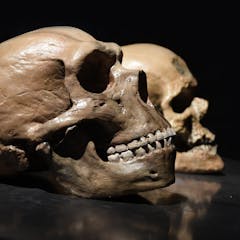
Articles on Neanderthals
Displaying 1 - 20 of 102 articles

A mysterious century-old law of genetics may explain the puzzling genetic legacy of our extinct Neanderthal cousins.

The two human species had many similarities but their communication would have been different.

Scientists can’t yet tell how soft tissue overlayed bones, so this reconstruction is inevitably based on artistic licence.

Neanderthals and humans may have been equally smart and skilled, but some evidence points to humans living in larger groups.

A new discovery is shedding more light on the overlap between the two species of human, despite the challenges of exploring this distant time

Genetic analysis of two skull fragments dating back almost 40,000 years shows that our species colonised Europe from the east and interbred with our Neanderthal cousins.

What could the extinction of Neanderthals tell us about our own species? An archaeologist explains in The Conversation Weekly podcast.

Meet the archeologist who is overhauling our understanding of early human history.

Archaeologists speculate the first soup might have been made by Neanderthals.

The analysis could help us understand behavioural differences between the two groups of humans.

Scientists had figured a fossil found in Spain more than a century ago was from a Neandertal. But a new analysis suggests it could be from a lost lineage of our species, Homo sapiens.

This whirlwind tour of social history describes how infectious diseases have shaped humanity at every stage. It suggests reducing inequality will give us our best chance of surviving future plagues.

In 2022 we detailed the discovery of 1,500 stone points in France’s Madrin cave. Experiments now show that they could were used as arrowheads, pushing back evidence of archery in Eurasia by 40,000 years.

It makes sense that a world of individuals used art to explore identity.

Hate winter? The answer may lie in our evolutionary history.

The way human brains develop is special – but not quite as special as you’d like to think, if we consider Neanderthals as well.

Neanderthals living in Italy swam confidently and In early Egyptian, Greek and Roman images people are shown swimming overarm. But today, only one in four people in low income countries can swim.

Humanity carries traces of other populations in our DNA – and a new study shows how one of these ancestors has influenced the immune systems of modern Papuans.

The first Neanderthal footprints from the Iberian Peninsula discovered last year may have belonged to other members of the genus ‘Homo’.

New study shows Neanderthals and Homo sapiens had a taste for sharp and bitter food.
